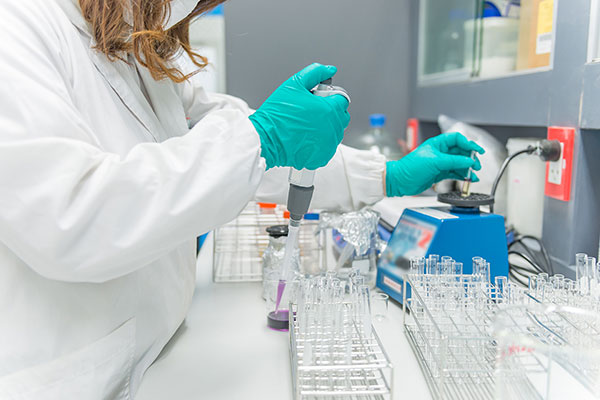Click Chemistry Reagents
- Alkynes
- Azides
- BCN Reagents
- Click Chemistry Ligands and Catalysts
- Controlled Pore Glass Solid Supports
- Cycloalkyne Dyes (DBCO)
- Hydrazides
- NHS Esters
- Phosphoramidites
- Tetrazines
- Trans Cyclooctene (TCO)
- Triphosphates
Customized Fluorescent Reagents
One-stop Solution for Your Research
BOC Sciences offers a one-stop solution for fluorescent reagents, providing custom synthesis, modification, and large-scale production services. Our comprehensive portfolio includes high-purity fluorescent dyes, probes, and labeling reagents for research and industrial applications, ensuring superior performance and reliability.
Explore More

Background
Introduction of Click Chemistry Reagents
Click chemical reagents are to use carbon-heteroatom bonding reaction to quickly realize molecular diversity. Click chemical reagents are generally covalent bonds formed by azide and alkyne, which have the advantages of high efficiency, stability and high specificity. Meanwhile, the reaction of clicking chemical reagents is not affected by pH, and can be carried out in water under normal temperature, or even in living cells. Click chemistry is also translated as "link chemistry" and "speed combination chemistry". The main idea is to quickly and reliably complete the chemical synthesis of various molecules through the splicing of small units.
Click chemical reactions can be divided into three generations.
- Cu (I)-catalyzed azide alkyne click chemical reactions (CuAAc).
- Strain promoted azide alkyne click chemical reaction (SPAAC) which is biocompatible.
- Connection between tetrazine and olefin (trans cyclooctene) which is a high-speed reaction and contains no copper.
The concept of click chemistry reagents has made great contributions to the field of chemical synthesis. In many fields such as drug development and biomedical materials, click chemical reagents have become one of the most useful and attractive synthetic ideas.
Types of Click Chemistry Reagents
- BCN
- Alkynes
- Azide
- DBCO
- TCO
- Tetrazine
- Ligands of click chemistry
BCN reagent is a kind of click chemical reagent containing highly active BCN (bicyclic [6.1.0] nonyne) group. BCN reagent can react with molecules or biomolecules labeled by azide through copper free click chemistry. It can be operated in aqueous buffer or organic solvent, depending on the characteristics of the substrate molecules. BCN reagent with polyethylene glycol (PEG) arms increases the hydrophilicity of the compounds. BCN reagent has been widely used in biological coupling, labeling and chemical biology.
Alkyne reagents can react with azide containing compounds or biomolecules through copper catalyzed azide alkyne click chemistry to produce stable triazole bonds. Alkyne NHS ester is used for biomolecular labeling with alkynyl groups and for copper catalysis. Biotin alkyne is a kind of reactive affinity tag that can be attached to biomolecules through click chemistry.
Azide click chemistry is a very popular chemistry. Because of its mild conditions, high speed and good biocompatibility, azide click chemistry is widely used in the field of pharmacy and biotechnology.
The first generation of azide click chemistry reagents are realized by the reaction of azide (N3) with alkynes (such as propargyl) in the presence of copper catalyst to form a stable triazole bond.
The second generation of azide click chemistry reagents uses azide molecules and structurally constrained alkynes without the use of copper.
The attraction of azide functional groups lies in their high selectivity and stability under most conditions. Azide reagents can be used for azido labeling of peptides and proteins.
DBCO reagents are a kind of click chemical labeling reagents, which contain very active DBCO ((dibenzocyclooctyne) groups. DBCO reagents can be used to label azide modified biomolecules without toxic copper catalyst. PEGylation can increase the solubility and stability of peptides and proteins, and reduce their immunogenicity. Meanwhile, DBCO-PEG reagents can also inhibit the nonspecific binding of charged molecules to the modified surface.
TCO (trans cyclooctene) click chemistry reagents are the third generation of click chemistry reagents. Because of their fast speed and good biocompatibility, TCO reagents widely used in labeling and biocoupling. TCO click chemistry is the reaction of TCO reagents and tetrazine in the reverse electron demand Diels-Alder reaction (DA), and then the reverse DA reaction to eliminate nitrogen.
Tetrazine reagents are a kind of click chemical labeling reagents containing reactive tetrazine groups. The structures of tetrazine reagents are shown in the figure 6. Tetrazine reagents and TCO reagents have high reactivity in the reverse electron demand DA reaction and the reverse DA reaction to eliminate nitrogen. This is a very rapid reaction for biocoupling at low concentrations in labeling living cells, molecular imaging and other biocoupling applications.
The efficiency of CuAAc catalyzed by copper largely depends on the presence of copper ion. Copper ion is easy to be oxidized and disproportionated, and also has cytotoxic effect on living cells. The ligand with tertiary amine and triazine can stabilize copper and accelerate the reaction. Due to the biorthogonality, low cytotoxicity and reaction rate, these ligands further expand the application of CuAAc in chemical biology.
Resources

- Hoechst Dyes: Definition, Structure, Mechanism and Applications
- Mastering the Spectrum: A Comprehensive Guide to Cy3 and Cy5 Dyes
- Fluorescent Probes: Definition, Structure, Types and Application
- Fluorescent Dyes: Definition, Mechanism, Types and Application
- Coumarin Dyes: Definition, Structure, Benefits, Synthesis and Uses
- BODIPY Dyes: Definition, Structure, Synthesis and Uses
- Cyanine Dyes: Definition, Structure, Types and Uses
- Fluorescein Dyes: Definition, Structure, Synthesis and Uses
- Rhodamine Dyes: Definition, Structure, Uses, Excitation and Emission
- Unlocking the Power of Fluorescence Imaging: A Comprehensive Guide
- Cell Imaging: Definitions, Systems, Protocols, Dyes, and Applications
- Lipid Staining: Definition, Principles, Methods, Dyes, and Uses
- Flow Cytometry: Definition, Principles, Protocols, Dyes, and Uses
- Nucleic Acid Staining: Definition, Principles, Dyes, Procedures, and Uses
- DNA Staining: Definition, Procedures, Benefits, Dyes and Uses
- Cell Staining: Definition, Principles, Protocols, Dyes, and Uses
- Ion Imaging: Definition, Principles, Benefits, Dyes, and Uses
- Fluorescent Labeling: Definition, Principles, Types and Applications
Online Inquiry

